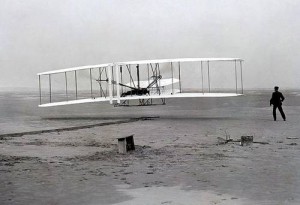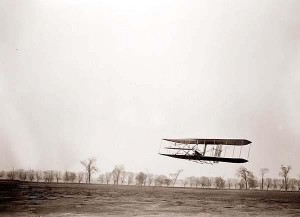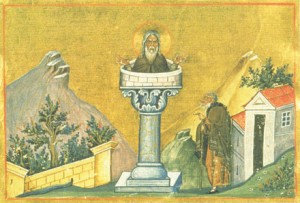 In the fifth century, St. Daniel, a stylite priest, lived on top of a pillar near Constantinople. He came down one time in 33 years. From his roost, “he preached sermons, dispensed spiritual advice, and cured the sick who were brought up to him. He also gave prudent counsel to Emperors Leo and Zeno and the patriarch of Constantinople.” Above the thick and shifting crowds, clear of enclosing tenements, he could meditate and pray, open to the sky. Imagine his sense of release, his sense of peacefulness. If you
In the fifth century, St. Daniel, a stylite priest, lived on top of a pillar near Constantinople. He came down one time in 33 years. From his roost, “he preached sermons, dispensed spiritual advice, and cured the sick who were brought up to him. He also gave prudent counsel to Emperors Leo and Zeno and the patriarch of Constantinople.” Above the thick and shifting crowds, clear of enclosing tenements, he could meditate and pray, open to the sky. Imagine his sense of release, his sense of peacefulness. If you 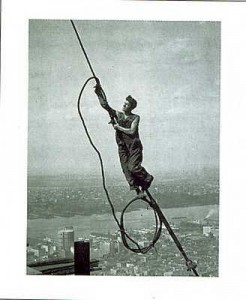 have ever climbed a hill, scaled a rock face, flown in a glider, stood on a tower looking away and down, you know the temptation of high places, their capacity to bewitch.
have ever climbed a hill, scaled a rock face, flown in a glider, stood on a tower looking away and down, you know the temptation of high places, their capacity to bewitch.
Now, we can fly, and there is no limit to our ‘up’.
Try to put aside your experiences of commercial flight; there is little peace, solitude or release to be found there. Instead, think of going up solo. William Langewiesche, an American writer and pilot, wrote this about flying: Nowhere can a person find greater solitude than alone in flight. Our universal dream, tens of thousands of years of desire, came to fulfillment here, in Kitty Hawk.
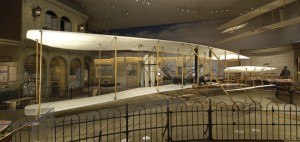 The Wright Brothers made their plane and called it ‘the Flyer’. Its engine weighed 200 pounds and produced 12 horsepower of force, about the same as a riding lawn mower; the whole plane without the pilot weighed 605 pounds. It has the look of something two bicycle mechanics would have put together — there is nothing of the mass-produced about it; it feels like a DaVinci sketch made animated and then real. I would not be surprised to see objects like it mounted in MOMA as installation pieces. It has the texture and bearing of modernity in its clean lines, its sharp angles, in its openness.
The Wright Brothers made their plane and called it ‘the Flyer’. Its engine weighed 200 pounds and produced 12 horsepower of force, about the same as a riding lawn mower; the whole plane without the pilot weighed 605 pounds. It has the look of something two bicycle mechanics would have put together — there is nothing of the mass-produced about it; it feels like a DaVinci sketch made animated and then real. I would not be surprised to see objects like it mounted in MOMA as installation pieces. It has the texture and bearing of modernity in its clean lines, its sharp angles, in its openness.
Trees now line the flight path they had laid out for their attempts, but in 1903, Kitty Hawk looked like a spit of desert between the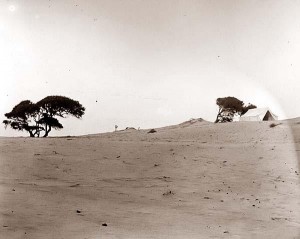 seas, a domain of sand and sky and birds. Kill Devil Hill, a vast, high dune lay to the south of their take-off and landing belt. The wind blew all the time. The space must have been empty and beautiful, beckoning, the sky enormous. They had solitude in which to work and all of that room to fill with their meditations.
seas, a domain of sand and sky and birds. Kill Devil Hill, a vast, high dune lay to the south of their take-off and landing belt. The wind blew all the time. The space must have been empty and beautiful, beckoning, the sky enormous. They had solitude in which to work and all of that room to fill with their meditations.
Of course ‘bicycle mechanic’ does not come close to describing the brothers’ talents as inventors, as artisans, as makers of machines, as practical men who also dreamed of launching themselves into the sky, maybe our most primal example of envy. Who has not looked at birds and immediately wished that he or she could think “Rise Up” and then find our heavy bodies released from all that keeps us earthbound? Who does not believe that he would be a wiser Icarus if given the chance?
On December 17, 1903, they made four flights powered by that engine; they flew into the wind so as to acquire lift. Each time they stayed aloft for longer distances — 120 feet, 175 feet, 200 feet and then a great leap of 852 feet. Orville and Wilbur both flew twice. I like that. Each of them experienced the sudden elevation, the motor to their right smashing its noise, the wings braced and steady, and then the purest happiness they must have ever felt. Each of them experienced the sight of a brother skipping up and away, riding that splendid machine and then feeling the surge of another loving, jubilant moment.
